Digital Poster
Hyperpolarized 13C MR
ISMRM & ISMRT Annual Meeting & Exhibition • 03-08 June 2023 • Toronto, ON, Canada

| Computer # | |||
|---|---|---|---|
 |
4323.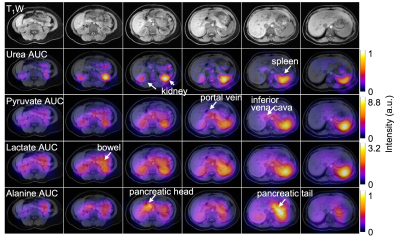 |
61 |
Co-Hyperpolarized [13C,15N2]urea + [1-13C]pyruvate for Perfusion
and Metabolic Imaging of the Abdomen in Healthy Volunteers
Yaewon Kim1,
Hsin-Yu Chen1,
Tanner Nickles1,
Jeremy Gordon1,
Peder Larson1,
Xiaoxi Liu1,
Louise Magat1,
Philip Lee1,
Daniel Gebrezgiabhier1,
Cornelius von Morze2,
Dan Vigneron1,3,
and Michael Ohliger1
1Department of Radiology and Biomedical Imaging, University of California, San Francisco, CA, United States, 2Mallinckrodt Institute of Radiology, Washington University, St. Louis, MO, United States, 3Department of Neurological Surgery, University of California, San Francisco, CA, United States Keywords: Hyperpolarized MR (Non-Gas), Perfusion [13C,15N2]urea and [1-13C]pyruvate were polarized together using dynamic nuclear polarization and simultaneously injected into healthy volunteers for simultaneous imaging of metabolism and perfusion in the abdomen. Whole-abdomen images were successfully obtained and the distribution of urea was compared to pyruvate and its metabolites. While the relative intensity in various organs were similar between urea and pyruvate, the temporal courses were different. This represents the first use of co-polarized pyruvate and urea in the human abdomen, and will be a powerful potential tool for simultaneous imaging of perfusion and metabolism in tumors and metabolic diseases. |
4324.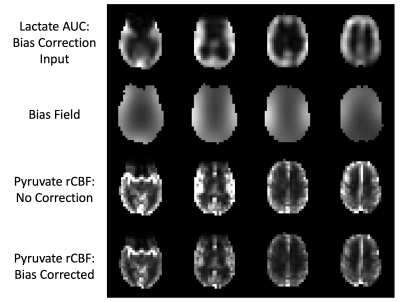 |
62 |
Bias Correction for Improved Quantification of Hyperpolarized
[1-13C]Pyruvate Cerebral Perfusion
Jasmine Hu1,
Sana Vaziri1,
Nikolaj Bøgh2,
Yaewon Kim1,
Adam Autry1,
Robert Bok1,
Yan Li1,
Christoffer Laustsen2,
Peder Larson1,
Duan Xu1,
Daniel Vigneron1,
and Jeremy Gordon1
1UC San Francisco, San Francisco, CA, United States, 2MR Research Center, Clinical Medicine, Aarhus University, Aarhus, Denmark Keywords: Hyperpolarized MR (Non-Gas), Perfusion, Brain Bias correction of hyperpolarized [1-13C]pyruvate brain MRI allows for improved quantification of cerebral perfusion. In the healthy volunteers studied, bias corrected pyruvate and ASL rCBF exhibited higher correlation than uncorrected pyruvate and ASL rCBF. We hypothesize that N4ITK bias correction can be used to remove low frequency inhomogeneities from hyperpolarized MRI before single-metabolite analyses. |
|
4325.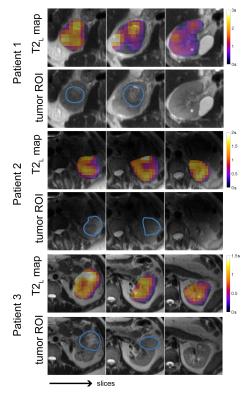 |
63 |
Estimating T2 relaxation rates of Lactate with Hyperpolarized
C13 MRI using bSSFP and Pharmacokinetic Modelling
Sule Sahin1,2,
Xiaoxi Liu1,
Nicholas Dwork3,
Shuyu Tang4,
Zhen Jane Wang1,
and Peder E.Z. Larson1
1Radiology, University of California, San Francisco, San Francisco, CA, United States, 2UC Berkeley - UCSF Graduate Program in Bioengineering, Berkeley, CA, United States, 3Biomedical Informatics, University of Colorado School of Medicine, Aurora, CO, United States, 4HeartVista, Los Altos, CA, United States Keywords: Hyperpolarized MR (Non-Gas), Modelling, Kidney, Tumor Lactate T2 values were fit in vivo for animal and human hyperpolarized carbon-13 pyruvate MR datasets. A pharmacokinetic model was used to leverage T2 weighting of a bSSFP acquisition. For healthy rat kidneys lactate T2 values were 0.929 ± 0.111s, for TRAMP tumor 1.663 ± 0.485s, for human RCC tumor 1.119 ± 0.168s and for human RCC normal-appearing region 1.089 ± 0.375s. Lactate T2 maps showed heterogeneity across the kidney of RCC patients but median T2 values were consistent across patients. This work demonstrates a method of using bSSFP hyperpolarized data to fit T2 values. |
|
4326.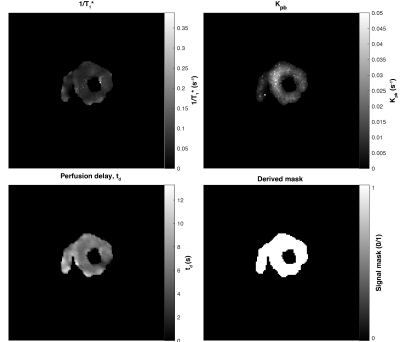 |
64 |
Fractional-order total variation penalised hyperpolarized
metabolic model fitting in the human heart
Jack J. Miller1,2,
Justin Y C Lau3,
Andrew Lewis4,
and Christoffer Laustsen1
1The MR Research Centre, Aarhus University, Aarhus, Denmark, 2OCMR, Radcliffe Department of Medicine, University of Oxford, Oxford, United Kingdom, 3GE Healthcare, Schenectady, NY, United States, 4OCMR, University of Oxford, Oxford, United Kingdom Keywords: Hyperpolarized MR (Non-Gas), Cardiovascular Fractional-order derivatives represent the smooth analytic continuation of differentiation by a non-integer order. Their use for total-variation spatial regularisation has been proposed as they effectively smoothly interpolate data from the entirety of the image domain, and are reported to avoid ``blocky'' artefacts and better capture edges. Here, we show that their use permits the rapid and parsimonious optimisation of a piecewise metabolic model in the human heart, able to reconstruct terms representing perfusion delay and apparent metabolic rate constants of interconversion. |
|
4327.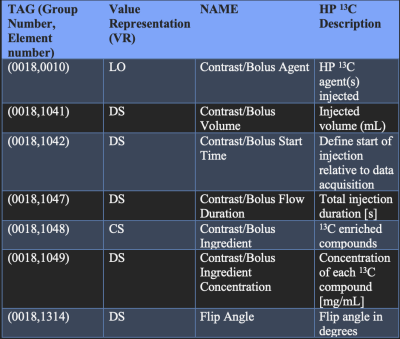 |
65 |
Data Standardization and DICOM Integration for Hyperpolarized
13C MRI
Ernesto Diaz1,
Renuka Sriram1,
Jeremey W. Gordon1,
Avantika Sinha1,
Xiaoxi Liu1,
Jenna Bernard1,
Daniel B. Vigneron1,
Zhen Jane Wang1,
Duan Xu1,
and Peder E.Z. Larson1
1Radiology & Biomedical Images, University of California,San Francisco, San Francisco, CA, United States Keywords: Hyperpolarized MR (Non-Gas), Contrast Mechanisms, Data,DICOM Hyperpolarized (HP) 13C MRI has shown promise as a valuable modality for in vivo measurements of metabolism, and is currently in human trials at over 15 human research sites worldwide. It is important to adopt standardized data storage practices as it will allow sites to meaningfully compare data. We propose using specific Attributes in DICOM format, including “Contrast Agents”, and provide a Python based implementation to add these values for individual studies. Moreover, we propose best practices for HP 13C MRI data storage that will support future multi-site trials and research studies and technical developments of this imaging technique. |
|
4328.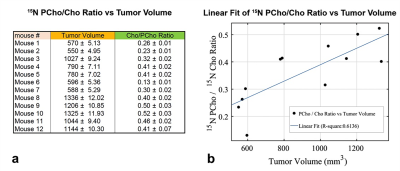 |
66 |
Hyperpolarized 15N choline chloride to study choline metabolism
in prostate cancer at 7T.
William Dominguez-Viqueira1,
Veronica C Estrella2,
Epifanio Ruiz1,
Gary V Martinez3,
and Jung W Choi4
1Small Animal Imaging Lab, Moffitt Cancer Center, Tampa, FL, United States, 2Moffitt Cancer Center, Tampa, FL, United States, 3MD Anderson Cancer Center, Houston, TX, United States, 4Radiology Department, Moffitt Cancer Center, Tampa, FL, United States Keywords: Hyperpolarized MR (Non-Gas), Cancer Elevated concentrations of choline and phosphocholine are known to be a metabolic hallmark for tumor hypoxia in prostate cancer. An inhibition of hyperpolarized 15N choline to phosphocholine conversion is shown in this work in hypoxic PC-3 cells in-vitro as seen by other methods in the literature. In-vivo tumor volumes and hyperpolarized 15N phosphocholine to choline ratios were measured in twelve NSG mice with subcutaneous flank xenograft PC-3 tumors, showing a moderate correlation. The findings in this work support the hypothesis that hyperpolarized 15N-Choline may be useful as a marker of malignancy. |
|
4329. |
67 |
Assessment of Cardiac TCA Cycle Activity with Hyperpolarized
[1-13C]Acetyl-L-Carnitine
Jun Chen1,
Tamara Kaur Singh2,
Sarah Al Nemri1,
Kelvin L Billingsley 3,
and Jae Mo Park1,4
1Advanced Imaging Research Center, UT Southwestern Medical Center at Dallas, Dallas, TX, United States, 2Chemistry, California State University, Fullerton, Fullerton, CA, United States, 3Chemistry and Biochemistry, Loyola University Chicago, Chicago, IL, United States, 4Department of Radiology, UT Southwestern Medical Center at Dallas, Dallas, TX, United States Keywords: Hyperpolarized MR (Non-Gas), Metabolism Hyperpolarized [1-13C]acetyl-L-carnitine was developed as a probe to investigate cardiac TCA cycle activity in vivo. [5-13C]Glutamate, which is produced via TCA cycle intermediate a-ketoglutarate, was successfully observed in rat heart under both fasting and fed conditions. Importantly, although pyruvate dehydrogenase activity is decreased in the fasted state, [5-13C]glutamate remained observable at appreciable levels, suggesting that [1-13C]acetyl-L-carnitine provides complementary information relative to standard assessments of pyruvate oxidation with hyperpolarized [1-13C]pyruvate. In turn, this novel probe may facilitate comprehensive metabolic analyses of acetyl-CoA uptake by the TCA cycle for various cardiac applications. |
|
4330. |
68 |
SABRE Hyperpolarization of Bulky, Nitrile Containing Anti-Cancer
Drugs, Letrozole and Anastrozole, with Long Hyperpolarization
Lifetimes
Keilian Macculloch1,
Austin Browning1,
Patrick TomHon1,
Soren Lehmkuhl1,
Eduard Y Checkmenev2,3,4,
and Thomas Theis1,5
1Chemistry, North Carolina State University, Raleigh, NC, United States, 2Wayne State University, Detroit, MI, United States, 3Karmanos Cancer Institute, Detroit, MI, United States, 4Russian Academy of Science, Moscow, Russian Federation, 5University of North Carolina, Chapel Hill, NC, United States Keywords: Hyperpolarized MR (Non-Gas), Cancer Signal Amplification By Reversible Exchange in Shields Enable Alignment Transfer to Heteronuclei (SABRE-SHEATH) was employed to boost 15N magnetic resonance sensitivity on common anti-cancer agents. The SABRE-SHEATH hyperpolarization dynamics of letrozole and anastrozole were independently optimized with respect to solution temperature and polarization transfer field. These studies enabled single scan 15N detection of the drugs at natural isotopic abundance working with mM concentrations for over 30 minutes, paving the way for more sensitive drug development. |
|
4331.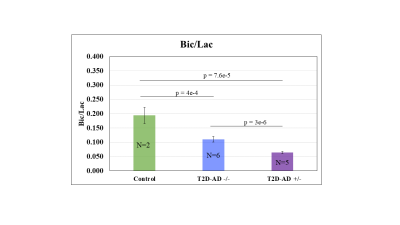 |
69 |
Metabolic Dysregulation in Rat Brain with Diabetes and
Alzheimer’s Disease as Assessed by Hyperpolarized [1-13C]
Pyruvate
Keshav Datta1,
Shie-Chau Liu1,
Usman Rehman2,
James Graham3,
Ralph Hurd1,
Daniel Spielman1,
and Thomas Jue2
1Radiology, Stanford University, Stanford, CA, United States, 2Biochemistry and Molecular Medicine, University of California, Davis, CA, United States, 3Nutrition, University of California, Davis, CA, United States Keywords: Hyperpolarized MR (Non-Gas), Alzheimer's Disease, Neurodegenerative Metabolism Diabetes MRI MRS Epidemiology studies have detected type 2 diabetes (T2D) increasing the risk of Alzheimer’s disease (AD). How insulin insensitivity in T2D influences AD onset/progression poses a puzzling question. In this study using dynamic nuclear polarization (DNP) magnetic resonance (MR) experiments, we interrogated the metabolic alteration by following the conversion of [1-13C]Pyr in the brain of control (CRL), T2D with no AD (T2D-AD -/-), and T2D with AD (T2D-AD +/-) rats. Pyruvate dehydrogenase (PDH) activity decreases in T2D and decreases further in T2D with AD. |
|
4332.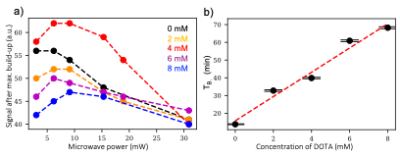 |
70 |
Effects of Gadolinium on the Dynamic Nuclear Polarization of
[15N3] Metronidazole
David O. Guarin Bedoya1,2,
Sameer M. Joshi3,
Anna Samoilenko3,
Mohammad S. H. Kabir3,
Atsushi M. Takahashi4,
Jan Henrik Ardenkjaer-Larsen2,5,
Eduard Y. Chekmenev3,6,
and Yi-Fen Yen1
1Radiology Department, Athinoula A. Martinos Center for Biomedical Imaging, MGH, Charlestown, MA, United States, 2Polarize ApS, Frederiksberg, Denmark, 3Department of Chemistry, Wayne State University, Detroit, MI, United States, 4Department of Brain and Cognitive Sciences, Massachusetts Institute of Technology, Cambridge, MA, United States, 5Department of Health Technology, Technical University of Denmark, Lyngby, Denmark, 6Russian Academy of Sciences, Moscow, Russian Federation Keywords: Hyperpolarized MR (Non-Gas), Contrast Agent, Contrast Mechanism In this work, we studied the dynamic nuclear polarization (DNP) process of [15N3]metronidazole (MNZ), an FDA-approved antibiotic that achieved good polarization (~6%) with very short polarization build-up time constants (~12min). We used Electron Paramagnetic Resonance (EPR) spectroscopy to show that a sample of [15N3]MNZ + trityl AH111501 had narrower EPR linewidth and larger magnitude than AH111501 alone, indicating an efficient polarization transfer from the radical electrons to 15N and supporting our observations of fast DNP buildup. We also demonstrated that an addition of gadolinium-based compound to the [15N3]MNZ +AH111501 sample broadened the EPR spectrum and prolonged DNP buildup as observed. |
|
4333.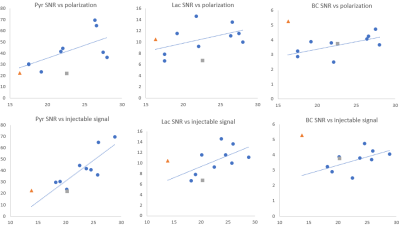 |
71 |
Factors influencing human brain metabolite SNR in studies with
hyperpolarized [1-13C]pyruvate
Mary McLean1,
Ashley Grimmer1,
Elizabeth Latimer1,
Alixander Khan1,
Pascal Wodtke1,
Joshua Kaggie1,
James Grist2,
Fulvio Zaccagna1,
Martin Graves1,
and Ferdia Gallagher1
1Radiology, University of Cambridge, Cambridge, United Kingdom, 2Physiology, Anatomy & Genetics, University of Oxford, Oxford, United Kingdom Keywords: Hyperpolarized MR (Non-Gas), Brain Human brain metabolite SNR in studies with hyperpolarized [1-13C]pyruvate was found to best correlate with percentage polarization in the liquid state and with the polarization adjusted for pyruvate concentration and the delay between dissolution and injection (‘injectable signal’). It did not depend on the volume of pyruvate injected, suggesting that the current dose (which is adjusted by body weight) is adequate. It may be worth further exploring whether the SNR of bicarbonate could be enhanced by a longer delay between injection and the start of acquisition. Liquid and solid-state polarizations did not correlate, highlighting the importance of liquid state measurement. |
|
4334.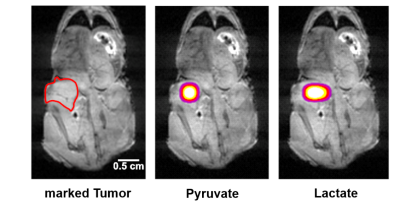 |
72 |
Para-hydrogen signal-enhanced 1-13C-pyruvate-d3 for rapid
metabolic tumor imaging
Henning Schroeder1,
Theresa Hune1,
Salvatore Mamone1,
Anil Jagtap1,
Sonja Sternkopf1,
Gabriele Stevanato1,
Sergey Korchak1,
Claudia Fokken2,
Christoph Müller3,4,
Dorothea Becker2,
Andreas Schmidt3,4,5,
and Stefan Glöggler1
1NMR Signal Enhancement, Max Planck Institute for Multidisciplinary Sciences, Göttingen, Germany, 2Department of NMR-based Structural Biology, Max Planck Institute for Multidisciplinary Sciences, Göttingen, Germany, 3Division of Medical Physics, Department of Radiology, Medical Center, University of Freiburg, Freiburg, Germany, 4German Cancer Consortium (DKTK), partner site Freiburg, German Cancer Research Center (DKFZ), Heidelberg, Germany, 5Intergrative Biosciences (Ibio), Department of Chemistry, Karmanos Cancer Institute (KCI), Wayne State University, Detroit, MI, United States Keywords: Hyperpolarized MR (Non-Gas), Cancer Using a Parahydrogen-induced polarization (PHIP) based approach, we enhanced the signal of pyruvate, one of the key metabolites for energy production in the body. By injecting this metabolite into a mouse carrying a human melanoma tumor, we could perform real time spectroscopy and visualization of the tumors metabolism using a NMR machine. This offers a fast and powerful tool for metabolic imaging without using radio tracers. |
|
4335.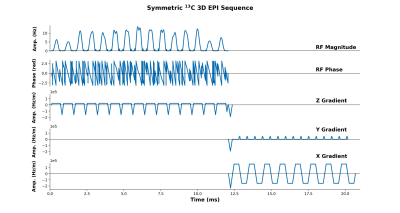 |
73 |
An open-source echo-planar imaging sequence for hyperpolarized
13C MRI
Tyler Blazey1 and
Cornelius von Morze1
1Mallinckrodt Institute of Radiology, Washington University in St. Louis, St. Louis, MO, United States Keywords: Hyperpolarized MR (Non-Gas), Hyperpolarized MR (Non-Gas) HP 13C MR imaging in humans has largely been restricted to GE scanners. To facilitate a human HP 13C imaging program at our institution and expand the translational potential of HP 13C MRI in general, we have developed a 3D symmetric EPI sequence for imaging HP 13C agents on Siemens scanners. Sequence development was performed using Pulseq, a flexible open-source tool for prototyping platform-agnostic pulse sequences. Metabolites were selectively excited using spectral-spatial RF pulses. Optional acceleration was achieved using partial Fourier undersampling in the slice direction. The sequence was tested using a thermally polarized phantom and a HP [1-13C]pyruvate phantom. |
|
4336.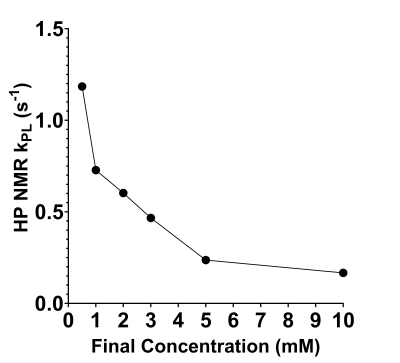 |
74 |
Quantitative Evaluation of kPL Dependence on Pyruvate
Concentration in Anaplastic Thyroid Cancer Cell Suspensions
using Hyperpolarized 13C NMR
Collin J. Harlan1,2,
Yunyun Chen3,
Gary V. Martinez2,
Vlad C. Sandulache4,
Stephen Y. Lai3,5,6,
and James A. Bankson1,2
1The University of Texas MD Anderson Cancer Center UTHealth Graduate School of Biomedical Sciences, Houston, TX, United States, 2Department of Imaging Physics, The University of Texas MD Anderson Cancer Center, Houston, TX, United States, 3Department of Head and Neck Surgery, The University of Texas MD Anderson Cancer Center, Houston, TX, United States, 4Department of Otolaryngology-Head and Neck Surgery, Baylor College of Medicine, Houston, TX, United States, 5Department of Radiation Oncology, The University of Texas MD Anderson Cancer Center, Houston, TX, United States, 6Department of Molecular and Cellular Oncology, The University of Texas MD Anderson Cancer Center, Houston, TX, United States Keywords: Hyperpolarized MR (Non-Gas), Translational Studies Metabolic imaging of hyperpolarized pyruvate can provide new insight into tumor progression and response to therapy. Pharmacokinetic modeling can be used to determine kPL, the apparent rate constant for conversion of hyperpolarized pyruvate into lactate. In this work, we sought to characterize the effect of hyperpolarized pyruvate concentration on intracellular kPL in ATC cell suspensions using a two-compartment pharmacokinetic model for kPL quantification. Improved understanding of the effects of concentration on intracellular chemical conversion rates could lead to more accurate quantification of in vivo and clinical hyperpolarized MRI imaging biomarkers of metabolism. |
|
4337. |
75 |
Increasing the hyperpolarization level on PHIP-SAH polarized
pyruvate in a fully biocompatible solution.
Francesca Reineri1,
Silvio Aime1,
Carla Carrera1,2,
Eleonora Cavallari1,
Erika Cerutti1,
and Ginevra Di Matteo1
1Molecular Biotechnology and Health Sciences, University of Torino, Torino, Italy, 2National Research Council, Torino, Italy Keywords: Hyperpolarized MR (Non-Gas), Hyperpolarized MR (Non-Gas), metabolism Hyperpolarized [1-13C]pyruvate can be obtained by means of ParaHydrogen Induced Polarization-Side Arm Hydrogenation, a hyperpolarization technique that is significantly more cost effective and faster than the gold-standard method d-DNP. The hyperpolarization level that we reported previously, for the fully biocompatible aqueous solution of this HP metabolite, was sufficient to carry out metabolic studies, but still low. In this work we show that the use of a lower catalyst concentration, together with a co-catalyst, and an improved magnetic field cycle profile for spin order transfer can double the HP level on this metabolite. |
|
4338.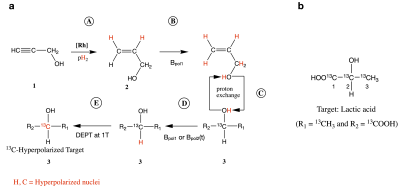 |
76 |
Efficient 13C-hyperpolarization of lactate using parahydrogen
and proton exchange.
Kolja Them1,
Jule Kuhn1,
and Jan-Bernd Hövener1
1Radiology and Neuroradiology, MOIN CC and SBMI, UKSH, Kiel, Germany Keywords: Hybrid & Novel Systems Technology, Hyperpolarized MR (Non-Gas), Hyperpolarized Lactate, Parahydrogen, Proton Exchange Hyperpolarization of biological molecules1,2,3 is a promising approach for metabolic MR imaging. Hyperpolarization methods based on parahydrogen and proton exchange4,5 promise almost universal polarization of many molecules, but current polarization yields are relatively low. Here, we present a new variant of Parahydrogen-Induced Polarization relayed via proton exchange (PHIP-X), which we demonstrate using the important biomolecule lactate. Polarization transfer between labile and covalent bound protons at different fields, combined with an RF pulse sequence, enables significantly enhanced 13C polarization of lactate. We believe that this approach may be used as a general strategy for the polarization of various biomolecules. |
|
4339.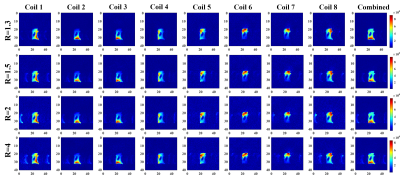 |
77 |
GRAPPA-Accelerated Flyback EPI with Controlled Aliasing for
Hyperpolarized Pyruvate
Enya E. Hachem1,
Sung-Han Li2,
Mai Huynh2,
Junjie Ma3,
and Jae Mo Park1,2,4
1Electrical Engineering, UT Dallas, Richardson, TX, United States, 2Advanced Imaging Research Center, UT Southwestern Medical Center, Dallas, TX, United States, 3GE Healthcare, New York, NY, United States, 4Department of Radiology, UT Southwestern Medical Center, Dallas, TX, United States Keywords: Image Reconstruction, Phantoms In this study, we introduced the parallel imaging technique GRAPPA to the flyback EPI with controlled aliasing in order to accelerate the acquisition time while simultaneously reducing artifacts. The GRAPPA-accelerated flyback EPI was characterized using MR phantoms with varying SNR and acceleration factor (R) and the feasibility of simultaneous bicarbonate and lactate imaging with the proposed scheme was also demonstrated. The proposed acquisition method has potential advantages for in vivo studies with hyperpolarized substrates by shortening acquisition time, improving spatial resolution, and increasing effective flip angles. |
|
4340.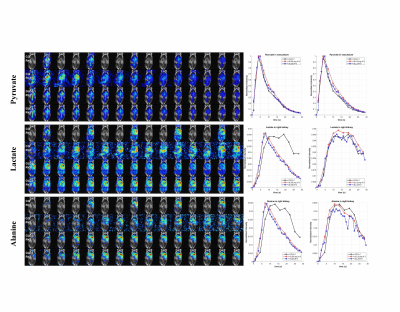 |
78 |
Improving temporal resolution in dynamic hyperpolarized 13C
spiral chemical shift imaging using low rank plus local sparse
reconstruction
Minjie Zhu1,
Dirk Mayer1,
Aditya Jhajharia1,
and Joshua Rogers1
1University of Maryland, Baltimore, Baltimore, MD, United States Keywords: Image Reconstruction, Hyperpolarized MR (Non-Gas) Improve the accuracy of under-sampled dynamic images for lower intensity metabolites with low rank and local sparsity reconstruction |
|
4341.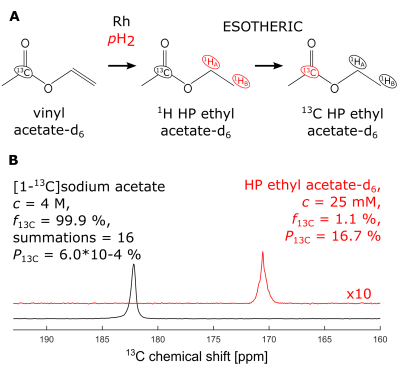 |
79 |
Towards Biomedical Applications of Parahydrogen Induced
Polarization by Side-Arm Hydrogenation Using SAMBADENA
Henri de Maissin1,2,
Obaid Mohiuddin1,
Marvin Herzog1,
Eduard Y. Chekmenev3,4,
Sergey Korchak5,6,
Stefan Glöggler5,6,
Jan-Bernd Hövener7,
Maxim Zaitsev1,
Dominik v. Elverfeldt1,
and Andreas B. Schmidt1,3,8
1Division of Medical Physics, University Medical Center Freiburg, Freiburg im Breisgau, Germany, 2German Cancer Research Center (DKFZ), German Cancer Consortium (DKTK), Heidelberg, Germany, 3Integrative biosciences (Ibio), department of Chemistry, Wayne state university, Detroit, MI, United States, 4Russian Academy of Sciences (RAS), Moscow, Russian Federation, 5NMR Signal Enhancement Group, Max Planck Institute for Multidisciplinary Sciences, Göttingen, Germany, 6Center for Biostructural Imaging of Neurodegeneration, University Medical Center Göttingen, Göttingen, Germany, 7Section Biomedical Imaging, Molecular Imaging North Competence Center, Kiel, Germany, 8German Cancer Consortium (DKTK), Heidelberg, Germany Keywords: High-Field MRI, Hyperpolarized MR (Non-Gas), parahydrogen cancer spectroscopy Parahydrogen-induced Polarization (PHIP) by Synthesis Amid the Magnet Bore Allows Dramatically Enhanced Nuclear Alignment (SAMBADENA) of agents in situ within the MRI magnet and requires very little hardware in addition to the MRI system. However, side-arm hydrogenation (PHIP-SAH), fast side-arm cleavage and purification have not been attempted yet.Here, we present a SAMBADENA setup made from commercially-available components for future preclinical applications. Using this setup, we demonstrate high 13C polarizations of 17% for 25mM ethyl-[1-13C]-acetate. In addition, for ethyl-pyruvate, fast side-arm cleavage and removal of 96% of the organic solvent within 10s to obtain pyruvate in neat water is demonstrated. |
|
The International Society for Magnetic Resonance in Medicine is accredited by the Accreditation Council for Continuing Medical Education to provide continuing medical education for physicians.